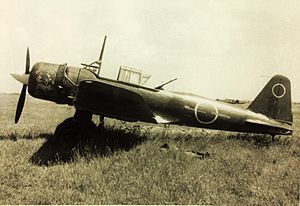

| Ki-51 | |
|---|---|

| |
| Mitsubishi Ki-51 | |
| Role | Light bomber/dive bomber
Type of aircraft
|
| Manufacturer | Mitsubishi Jukogyo KK |
| First flight | mid-1939 |
| Primary user | Imperial Japanese Army Air Service |
| Number built | 2,385[1] |
The Mitsubishi Ki-51 (Army designation "Type 99 Assault Plane"; Allied reporting name "Sonia") was a light bomber/dive bomber in service with the Imperial Japanese Army during World War II. It first flew in mid-1939. Initially deployed against Chinese forces, it proved to be too slow to hold up against the fighter aircraft of the other Allied powers. However, it performed a useful ground-attack role in the China-Burma-India theater, notably from airfields too rough for many other aircraft. As the war drew to a close, the Japanese began using them in kamikaze attacks. Total production was around 2,385 units.
On the day Hiroshima was destroyed by an atomic bomb, a single Ki-51 was responsible for the last Japanese sinking of a US warship, sinking USS Bullhead (SS-332) with all hands.
Charles Lindbergh, flying a P-38 Lightning, shot down a Ki-51.[2]


Data from Japanese Aircraft of the Pacific War[4]
General characteristics
Performance
Armament
Aircraft of comparable role, configuration, and era
Related lists
|
Mitsubishi aircraft
| |||||||||||||||||||||
|---|---|---|---|---|---|---|---|---|---|---|---|---|---|---|---|---|---|---|---|---|---|
| Company designations |
| ||||||||||||||||||||
| Imperial Japanese Army early designations |
| ||||||||||||||||||||
| Imperial Japanese Army short designations |
| ||||||||||||||||||||
| Imperial Japanese Navy short designations |
| ||||||||||||||||||||
| World War II Allied reporting names |
| ||||||||||||||||||||
| Japanese Self-Defense Force designations |
| ||||||||||||||||||||
| Company divisions |
| ||||||||||||||||||||
|
Tachikawa aircraft
| |
|---|---|
| Imperial Japanese Army types |
|
| World War II Allied reporting names |
|
|
Mansyu/Manshu aircraft
| |
|---|---|
| Mansyu developments |
|
| Civil aircraft |
|
| licensed production |
|
|
Imperial Japanese Army Air Service aircraft designations
| |
|---|---|
| 1-50 |
|
| 51-100 |
|
| 100- |
|
|
| |
|---|---|
| Aircraft in Japanese service |
|
| Foreign aircraft thought to be in Japanese service |
|